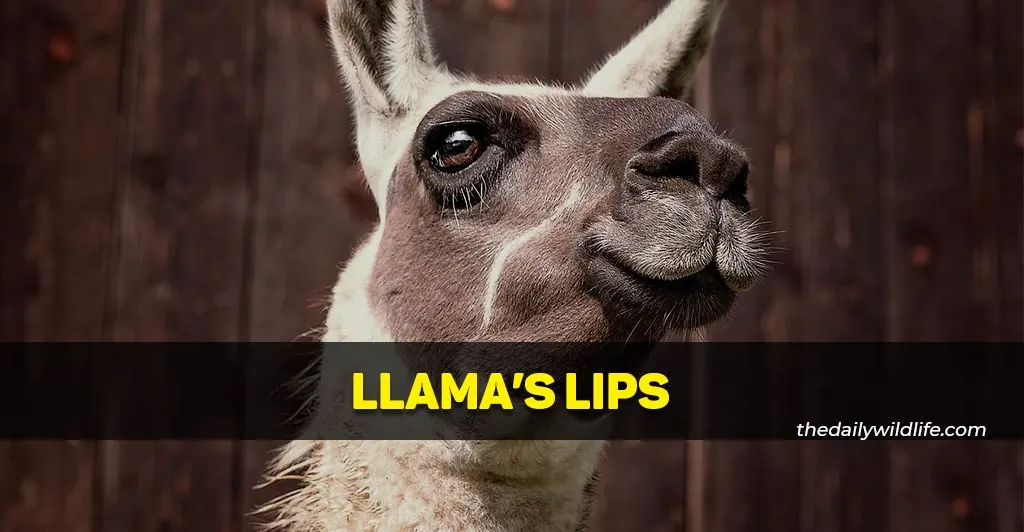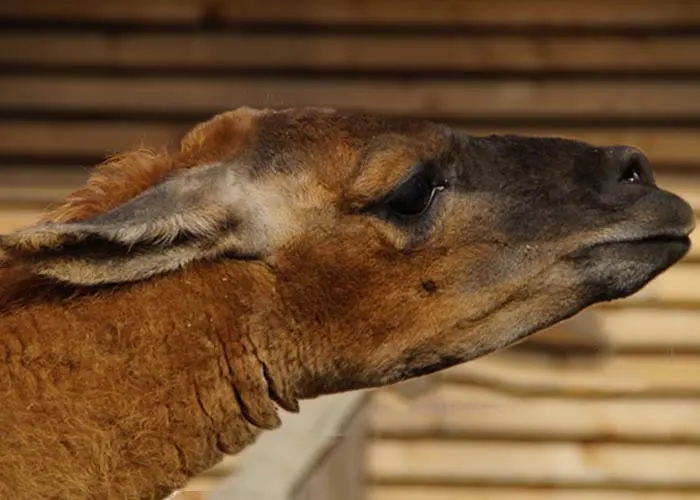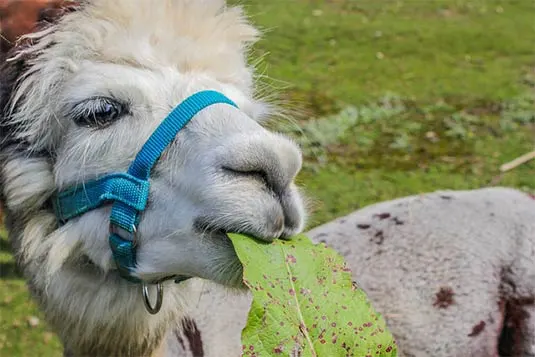To browse and graze with maximum effect, llamas have two highly flexible lips that allow them to grab the plants easily. They do not have upper incisor teeth, but a dental palate at the top of their mouth they grind the food onto.
Mature llamas, on the other hand, have razor-sharp curved fighting teeth they use to bite off the testicles of mating rivals. Ouch.
But despite that, people fall in love with these animals largely because of their heads. Llamas have beautiful eyes, long eyelashes, and adorable lips that appeal to many owners.
We always say that their long lips add a lot to their beauty. That’s what we will talk about today.
In this article, you will learn:
- What do llamas’ lips look like
- How llamas move their lips
- What do llamas use their lips for
- How to recognize different lip diseases of your llama

Table of Contents
What Do Llama’s Lips Look Like?
Llamas have prehensile lips. That means that llamas can grab and maneuver items with them. Their lips are almost the same as fingers in humans; the lips are that flexible. The lips are thin and the upper lip protrudes slightly beyond the lower lip.
Llamas have cleft lips. This means that the llamas’ upper lips are split in two and that they use them to grab, rotate, and manipulate different foods and items.
There have been many owners complaining how their llama used its lips to untie knots or open gate doors.
When it comes to anatomy, llama’s lips consist of:
- The upper lip
- The lower lip
- Pliltrum (labial cleft)

The upper lip of a llama is split by a philtrum, the vertical groove between the base of the nose and the border of the upper lip. It divides the upper lip into halves.
Llamas can move each part of the upper lip independently, via a muscle called levator nasolabialis. It is a facial muscle that is under the control of the facial nerve.
The upper lip is very tactile, very useful for fine discrimination; that’s why llamas use it as a sense organ to investigate potential food. Because the lip is that sensitive and mobile, it partially plays a similar role to the tongues of ruminants.
The lower lip has no unique characteristics and it is less sensitive than the upper lip. Compared to goats and sheep, a llama’s lower lip is less mobile.
Further reading: Llama Vs Sheep – similarities and differences
Llamas and alpacas will selectively graze or browse plants in environments where there are not too many plants rich in nutrients.
They will use their lips to investigate the potential feed. Because of this careful feeding behavior, llamas will seldom swallow some non-edible object that can’t properly reach and pass through their gastrointestinal tract.
Do Llamas Have 3 Lips?
People make a common mistake by looking at the llama’s lips and thinking that they have 3 lips.
Llamas do not have 3 lips; they have two lips in total. The upper lip is split into two parts. Together with the lower lip, this only gives an illusion that the llamas have 3 lips, which is not the case.
Take a look at this video of a llama from Machu Pichu in Peru trying to grab a banana. Notice how the upper lips are moving and trying to grab the fruit, while the lower lip almost does nothing.
What Do Llamas Use Their Lips For?
Besides grabbing and manipulating food and objects, llamas use their big lips to communicate with members of their herd. They will use their lips to whistle and hum; this is how llamas express how they feel.
For example, a llama that is annoyed and feeling aggressive will snort. This sound is characterized by a short burst of air through the mouth with lips held loose.
And if you notice a llama lowering its ears and holding them close to its head, take it as a warning sign and back off. The llama is probably going to spit on you because you annoyed it too much.

During mating, males will produce lots of specific sounds. They will breathe heavily, dilate their nostrils, and contract their lips and nostrils as they force air out of their mouth.
Some males do not make any sounds and are quiet while mating with a female.
Llamas have rather short and not very flexible tongues. The tongue rarely protrudes outside the mouth and lips. That’s why you will not see too many llamas licking their lips.

Lip Disorders And Injuries In Llamas
Your llama might suffer from different diseases and injuries to the lips: lacerations, wounds, swellings, erosions, ulcers, lesions, inflammations, and similar.
A llama might tear or cut its lips on a barbed wire on your fence, by some other sharp object in the environment. Sometimes, a dog or even a snake might bite the llama’s lips; a llama might injure its lips with its incisor teeth or during a fight with another male.
Different diseases (foot-and-mouth disease, stomatitis) or grass awns (yellow bristle grass, foxtails, etc) can cause erosions and ulcers on the external and internal surfaces of the lips.
Occasionally, because of the damage to the facial nerve, a llama might suffer from paralysis of the lips.
A llama might get an inflammation as a response to injury or disease of its lip tissue. You might notice that the llama lost its appetite, chews in a peculiar motion, salivates a lot, has bad breath, ulcers, erosions, etc.
Llamas hate someone touching their lips, so you might want to sedate the animal to examine the mouth and carry out diagnostic procedures.
In any case, you should consult with a veterinarian about the best treatment procedure.
Llama Lips Facts
- Llamas have mobile and prehensile pairs of upper and lower lips. Llamas use their lips to reach and manipulate food before moving it to the mouth.
- Llama’s upper lip is cleft and split in half by a philtrum. These two parts can move individually.
- The lips are controlled by a facial muscle called levator nasolabialis.
- The lips are 2-3 inches (5-7 cm) long and help llama reach tall leaves and plants and grasses on the ground.
- The upper lip is very sensitive and tactile; that’s why it is rare for a llama to swallow some gastric foreign body.
Final Thoughts
This concludes our article talking about llama lips.
Llamas have long, flexible, and prehensile lips they use to grab food and move it to their teeth for further shredding. The lips are around 2.5 inches (6 cm) long, and together with a llama’s long neck help reach tall trees and leaves.
The upper lip is split in half and each part can move individually. It is a lot more sensitive than the lower lip.
References:
[1] Fowler, Murray. Medicine and surgery of camelids. John Wiley & Sons, 2011.
[2] Cebra, Chris, et al. Llama and alpaca care. Elsevier Health Sciences, 2014.